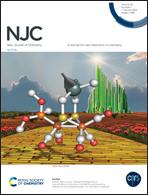Polyaniline@MOF fiber derived Fe–Co oxide-based high performance electrocatalyst†
Abstract
Electrochemical energy conversion and storage are important and coupled with a number of electrocatalytic processes. Renewable hydrogen, as a promising energy carrier, is closely related to the oxygen evolution reaction (OER). However, the OER kinetics is slow due to the slow 4e− transfer process. The low-cost transition metal-based catalysts provide broad prospects for the development of efficient and stable OER catalysts. Designing an efficient transition metal-based OER catalyst is beneficial to improve the overall efficiency of water decomposition. Here, we developed a new three-dimensional carbonized polyaniline fiber material loaded with Fe–Co oxide nanoparticle (denoted as 3D-CPF/FeCoOx-Nanoparticles) material by doping Fe to activate the catalytic activity of cobalt-based catalysts, introducing new reaction pathways and using the synergistic enhancement between metal nanoparticles and carbonized polyaniline fibers. Benefiting from the synergistic enhancement of the conductive three-dimensional carbonized polyaniline fibers and the high catalytic activity of FeCoOx nanoparticles, the 3D-CPF/FeCoOx-Nanoparticles only need a potential of 1.63 V to obtain a current density of 10 mA cm−2. Excitingly, the 3D-CPF/FeCoOx-Nanoparticles have exhibited potential applications in supercapacitors.



 Please wait while we load your content...
Please wait while we load your content...